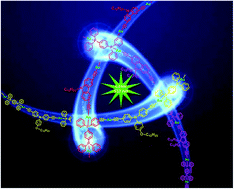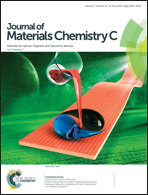Novel AuI polyynes and their high optical power limiting performances both in solution and in prototype devices†
Abstract
Three novel AuI polyynes have been prepared in high yield by copolymerization between an AuI complex precursor and different ethynyl aromatic ligands. The investigation of their photophysical behavior has indicated that forming polyynes through polymerization not only maintains the high transparency of the corresponding AuI polyynes similar to those of their corresponding small molecular AuI acetylides, but also effectively enhances their triplet (T1) emission ability. Critically, owing to their enhanced T1 emission ability, all the AuI polyynes exhibit a stronger optical power limiting (OPL) ability against a 532 nm laser than the corresponding small molecular AuI acetylides. The AuI polyynes based on fluorene and triphenylamine ligands show even better OPL performance than the state-of-the-art OPL material C60, indicating their great potential in the field of laser protection. More importantly, in a prototype OPL device made by doping the fluorene-based AuI polyyne into a polystyrene (PS) solid matrix, substantially improved OPL activity has been observed compared with that in the solution, demonstrating its great potential for practical application. All these results have provided a new strategy to achieve a balance between high OPL activity and good transparency for OPL materials, representing a valuable attempt towards developing new OPL materials with high performance to cope with the key problems in the field of nonlinear optics.



 Please wait while we load your content...
Please wait while we load your content...